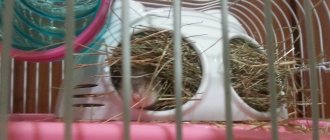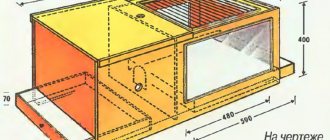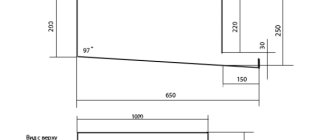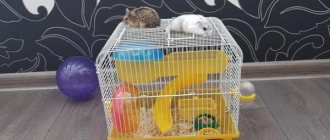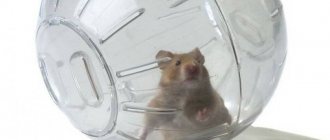- home
- Housing
16.07.2018
The hamster is a nimble animal that is very active at night. During daylight hours the animal sleeps. So that he has a resting place, you can make a house for your hamster with your own hands.
Design features of a house for rodents
Any structure installed in the cage must be made of environmentally friendly materials. Small rodents will definitely start sharpening their teeth on the house. Pieces containing harmful chemicals, once in the stomach of an animal, can cause its death.
It is advisable to divide the internal space into 2 zones: in one part of the home the pet will sleep, in the other - to store its supplies.
House dimensions
Before you make a hamster house with your own hands, you need to determine the dimensions of the pet. Djungarian or Syrian (golden) rodents are most often kept as pets. The body length and weight of animals vary depending on the species:
- Syrian - 13-13.5 cm, 100-125 g;
- Djungarian - up to 10 cm, 25-65 g.
The largest representatives of the hamster subfamily are animals of the species Cricetus cricetus, or the common hamster. Their body length can reach 34 cm. But such rodents are extremely rarely kept at home.
Determine the size of your pet before building the house.
When designing a house for a small hamster, you should adhere to the dimensions of the side walls 10x10 cm, the front and back - 15x10 cm, the roof - 17x12 cm. Depending on the size of the animal, these values increase proportionally.
Form
When choosing the shape of a pet's house, you need to consider the following:
- The interior of the structure must be easily accessible for cleaning.
- You should not leave wide gaps in the corners of the structure where your pet could get stuck trying to crawl through them. The inlet hole, on the contrary, should be large enough. Otherwise, a large rodent will not be able to get into the home.
The shape of the house depends on the type of building material and can be standard, semicircular, rectangular, etc. The dwelling is made one- or two-story. In the latter case, it is equipped with a ladder.
The floors in the house are not designed for rodents. They will interfere with cleaning the interior space from wool and debris.
The shape of the home should be such that it is convenient for the pet to move around in it.
Materials
A homemade design can be made:
- made of wood (thin planks, ice cream sticks, bars);
- peeled coconut;
- organic glass;
- food plastic;
- ceramics;
- vines;
- thick cardboard (toilet paper roll, box, etc.).
The structure can be made of wood.
In addition, remnants of fiberboard or chipboard are acceptable for use. It is forbidden to make a home for a rodent from polystyrene foam, polystyrene foam, polyurethane, OSB plywood, because they contain toxic substances and, if ingested by an animal, can lead to its death.
Home accessories
In order for the rodent to like the house and for the baby to grow up healthy and active in it, the housing needs to be filled with suitable accessories..
Educational toys for hamster
- Running wheel. Its dimensions depend on the size of the rodent: for the Djungarian it is a twenty-centimeter toy, for large specimens, including Syrian ones, up to 30 cm. The path on it must be continuous; it is not permissible to use a mesh for this, which can cause injury. It is important to know that hamsters like to stay awake at night, so the toy should be silent.
- Tunnels. They should be spacious and well ventilated.
- Hammocks for a hamster made from tubes of different diameters or a swing in the form of four posts, a crossbar and a perch for sitting.
- Wooden bridges or other objects for developing hamster teeth. It is good to use mineral stones and crayons. Cardboard boxes, toilet paper rolls, and branches of fruit trees are also suitable for these purposes.
- A walking ball made of safe plastic in different colors with ventilation holes and recesses for the paws.
Drinking and eating facilities
It is very important to choose the right feeder and water bowl for your rodent.
There must be a special drinking bowl in the house for drinking. You can make it yourself or use a bowl, which should be covered so that food or parts of the bedding do not fall into it. Small species of hamsters like to dig up pieces of food, so you can put them in the bedding. Large specimens require a stable food bowl that is difficult to tip over.
It is better to provide 2 containers - one for wet food and the other for dry food. Typically, rodents like to sit in the feeder, so it should be spacious enough. It is also important that there is a separate “pantry” for supplies that the hamster will definitely make. This could be a container in a secluded corner of the house. The hamster himself will “tell you” where his hiding place is, you just have to watch him carefully and then place a bowl there.
Hamster bedding
Bedding is very important for keeping the house clean and creating comfort and coziness. It can be pressed sawdust, but not too small so that it gets into the baby’s nose or gets tangled in his fur.
If wood pellets are used, they should be odorless and quickly turn into dust. Sawdust from coniferous trees can cause allergies in the animal, and fabrics and cotton wool are dangerous because they can tear into fibers in which the hamster can become entangled.
The best bedding materials for a hamster in a house are pieces of corn cobs with kernels, which can also be buried. Paper napkins or white unscented toilet paper are suitable for this.
The floor layer should be at least 6 cm deep, because hamsters love to play and burrow into it. When it gets colder, its thickness increases. It needs to be cleaned daily and changed once a week. A little granules from the previous bedding should be added to the fresh litter so that the familiar smell remains, otherwise the animal will become nervous.
Toilet
Hamsters are known for their cleanliness, so they need a separate place in the house for the toilet. You will have to clean it daily, removing waste and adding clean bedding. A cardboard tray is well suited for this purpose; this material is replaced quite often, because... it absorbs urine well, partially absorbing its odor.
The litter filler is often special clean sand, which the animal likes to rummage in, scattering it around. But sand does not hold odors well, so it needs to be changed often. Cat litter or mineral granules are not suitable for this - they can cause poisoning or allergies in your furry friend.
Sand bath
This is an important element of equipping a house for a hamster that does not like water treatments. They can be successfully replaced by bathing in special sand for chinchillas. To clean the fur from grease and dirt, place a high container with a ladder in the house. Let's assume an option with a hole cut in the side. It is closed on top with a lid that prevents the contents of the container from spilling out. The volume of the bath should be twice the size of the furry pet, and its sides should be high enough.
How to choose materials for a hamster house
If you want to build a house for a rodent, you should focus on the durability of the structure. So, a home built from cardboard will not last long. It will only be a temporary shelter. A structure made of wood is more reliable, but a pet can chew it quickly enough. The strongest houses are made of glass, food-grade plastic and ceramics. They are reliable, durable, easy to wash during cleaning and clean from dust.
Lego structures, hollow parts from children's toys, glass and plastic jars and containers, etc. can be used as housing for a hamster.
A house made from a stand for toothbrushes or stationery will look original.
Very simple houses made from toilet paper tubes
It may be difficult to call this structure a dwelling in the general sense of the word, but they are suitable as shelters for animals. They are non-toxic, hidden from view and well ventilated.
For homemade tube houses, not only toilet paper is suitable, but also paper towels. Take the tube and flatten it. Using scissors, cut a semicircle on each side. Do the same operation with the second tube. Insert one tube into the hole of the other. This cross-shaped structure is suitable for dwarf hamsters.
What is needed to build a house
When starting to arrange a home for a rodent, stock up on the necessary materials and tools. Suitable for filling:
- pieces of paper and napkins;
- large sawdust.
Large sawdust is suitable for arranging a house.
They can be placed in the hamster’s house or left near the structure. The animal will carry everything on its own and put it in the place where it will be more convenient for it. Do not place fabric, cotton wool or wool in the cage. Fibers from such materials can get into your pet's stomach and cause indigestion. In addition, it is undesirable to use scraps of newspaper sheets, because... Printing ink may contain compounds harmful to the health of the animal.
Tools
Depending on the type of dwelling, the following are used as devices for the manufacture of structures:
- knife or scissors;
- ruler;
- sandpaper;
- awl, etc.
Some designs will require pre-production of a template.
Shelter drawing
If the owner does not plan to use a ready-made structure as a shelter for the hamster, it is necessary to make a drawing. It is designed taking into account the size of the pet and the shape of the structure. The home should not be too cramped or spacious. For a large Syrian hamster, it is enough to equip a house 16 cm long, 8 cm wide and 7 cm high.
Drawing of a house for a hamster.
If the structure will be assembled from several elements, for example plastic bottles, the joints are marked on the diagram. On the drawing of a two-story dwelling, a staircase is drawn.
Step-by-step instructions for making a hamster house
When arranging a home for a rodent, try to avoid the use of small parts and sharp corners. The design should be comfortable and safe for your pet.
From plastic containers
Housing made from plastic bottles is easy to make and install. It can be replaced at any time with a new design. This house is suitable for both small and larger animals.
For the first option you will need to take:
- 2 drink bottles of 1 and 1.5 liters;
- scissors;
- stationery knife;
- electrical tape.
The necks of the bottles are cut off. Then the edges of the cuts are carefully covered with electrical tape. This is necessary so that the pet does not get hurt on the sharp edges of the plastic when using the structure.
Then a hole is cut in the side of the 1.5-liter container, the size of which is equal to the diameter of the second bottle. As a result of such manipulations, the plastic may crack, so first of all, a hole in the shape of a cross is made in the wall. Then, using scissors, it is enlarged. Treat the sections with electrical tape and insert one container into another. The structure in the shape of the letter “T” should not fall apart; for reliability, it is wrapped with electrical tape.
The house can be made from plastic containers.
To make the home more comfortable for pets, the transparent plastic outside can be covered with dark paper. This will prevent the penetration of light, which can interfere with the hamster's sleep.
The second housing option can replace the cage. To make the structure you will need to take:
- Several containers with a volume of at least 5 liters. Each bottle will be used as a separate room for your pet. The owner himself determines their number and the size of the home.
- Scissors.
- Electrical tape.
Then you need to cut off the top of the containers so that plastic funnels about 3 cm deep with a neck at the end are formed. The covers need to be removed. The sections are covered with electrical tape. A hand should be able to fit into the bottles; this will allow you to clear the pet’s home of debris. Holes equal to the diameter of the neck are made in the lower part of the flasks. Then the containers are connected to each other by inserting a funnel into one bottle and screwing the neck into the wall of the other. It turns out several separate spaces connected by transitions.
One of the flasks can accommodate a wheel and a hammock, creating a playroom. In the second they install a feeding trough and water bowl, in the third - a toilet, in the fourth they set up a bedroom for a pet, etc.
From cardboard and boxes
The simplest option for arranging a home made of cardboard is to use a ready-made box for shoes or other small items. The container is cut to the required size, then an inlet hole is made. Cardboard houses for dungeons can be equipped with transitions made from toilet paper rolls. This option is not suitable for Syrian hamsters - large animals can get stuck in the tunnel.
A simple house is made from cardboard and boxes.
It is not advisable to use juice or milk cartons that are lined with foil on the inside and do not allow air to pass through.
From a plastic container
Have to take:
- food container of a suitable size;
- sharp knife;
- lighter or matches.
The container is installed upside down. Then use a knife to cut the entrance hole. The edges of the plastic are melted with a lighter or matches so that they become smoother and the pet cannot get hurt.
For the house, take a food container of a suitable size.
Plastic boxes for storing cereals can also be used for rodent living. Such containers are equipped with lids with a hole through which the pet can get inside. The box is laid on its side. At the bottom of the container you need to pour sawdust from hardwood or lay scraps of clean paper.
Wooden house
To make a simple design you will need to take:
- a wooden board no more than 1 cm thick;
- ruler;
- pencil;
- jigsaw;
- sandpaper;
- hammer;
- thin small nails.
A wooden house is cut out of parts.
4 parts are cut out of the board, corresponding to the size of the pet. For example, 2 will have a length of 13 cm, and 2 others will have a length of 15. An inlet hole is cut in a small workpiece. In the walls 15 cm long, you can make small windows through which air will penetrate. The cuts must be thoroughly sanded with sandpaper.
The parts are then knocked together into a single structure.
You need to make sure that the point of the nails does not stick out from the wood, otherwise the animal may be injured.
A thin plywood sheet of the required size is used as a ceiling.
From coconut shell
This house is suitable for small hamsters, such as dwarf hamsters. To create a home you will need to take:
- coconut;
- hacksaw;
- knife;
- sandpaper;
- square wooden stand.
A house for small hamsters is made from coconut shells.
The nut is opened, removing the milk. Then, using a knife or hacksaw, an entrance hole is cut 2 cm below the eyes. Thoroughly clean the shell from the pulp, wash it and leave it to dry. Afterwards, the cuts and surface of the walnut are sanded using sandpaper. The finished product is attached to a wooden stand with glue or a screw.
From plywood
To build a home they take:
- a piece of plywood;
- ruler;
- pencil;
- jigsaw;
- hammer;
- small nails;
- sandpaper.
Plywood is used to build a home.
2 side walls measuring 10x10 cm are cut out, the front and back are 10x15 cm each. For a large hamster’s house, the size of each part must be proportionally increased by several centimeters. For the roof, take a sheet of plywood 12x17 cm. It is advisable to make windows in the side walls for additional ventilation.
The parts are sanded with sandpaper, then knocked together into a single structure. The roof is placed on top.
From old toys
Plastic parts from toys can be used as a home for a hamster. For example, this could be the head of a large doll or the cab of a truck. Using a hacksaw or soldering iron, make an inlet hole in the part, then remove the burrs by sanding the sections with sandpaper.
A ceramic figurine can also serve as a home for a small hamster. You will need to make an entrance in it using a jigsaw or a manual tile cutter. Such a ceramic house must have additional holes for air intake.
From paper
This type of housing is suitable for small pets. You will need to take:
- toilet paper or napkins;
- balloon;
- bowl of water.
To make a house, the ball is covered with paper.
The balloon is inflated so that its diameter matches the size of the future house. Paper or napkins are torn into pieces and placed in a container with liquid. Then they spread it over the surface of the ball, forming a small inlet hole. You will need at least 8 layers of paper. The papier-mâché is then dried using a hair dryer or battery.
The ball is pierced with a needle and removed. If necessary, adjust the size of the passage for the animal.
From the constructor
You can create an unusual shelter for your pet using LEGO construction kits. If there are a sufficient number of elements, you can create several rooms by connecting them with tunnels. To prevent the rodent from taking away small parts, it is recommended to fasten them with glue.
Shelter for animals made from plastic bottles
Such houses can be made for small and large hamsters. It all depends on the size of the bottle. There are many options for housing design, we will consider 2.
A simple one-bottle shelter option
To build a house, let's take a bottle that fits the width of the bottom for the animal. The lower part of the dish will be a shelter for the hamster. We cut off this part of the bottle, turn it over with the cut side down and make a semicircular entrance. Using a hot knitting needle, we pierce holes for air exchange around the perimeter of the house. We cover the cut edges of the bottle and the entrance with electrical tape so that the hamster does not get injured from the sharp edges. You can not cut out the entrance, but put a piece of the bottle on its side, and its cut will serve as the entrance. The container should be dark so that the animal feels protected.
House of two bottles
Using two bottles you can make a slightly more complex design.
Both containers are processed the same way. We cut off the bottom and neck of them. We wrap the edges first with electrical tape. In the middle of the first bottle we make a hole the same size as the second one. We do this using a stationery knife. First we make a cross-shaped cut, then bend the edges, being careful not to pull too hard. The plastic is very fragile and can crack. Insert scissors and cut a hole. Apply electrical tape to the circle. For a tighter fit, we flatten the edges of the bottle that we will insert into the hole and cut off the top and bottom edges diagonally. Wrap the edge with electrical tape. We insert the bottle into the first one. If the edges fit tightly enough, we tie the two bottles together with electrical tape.
Photo examples of interesting homemade products
By making a shelter for rodents yourself, you can make all your fantasies come true. The main thing is to remember that the animal should be comfortable in its home.
A paper house requires minimal investment.
A wooden house will last a long time.
A house made from plastic containers is very convenient.
Where should the cage be?
If you have other pets, then first of all the hamster’s home should be located so that other pets cannot harm the new “family member”. On the one hand, the hamster should live among other inhabitants of the house, on the other, the cage should be located where unnecessary sounds or light will not disturb it, especially during the daytime rest.
IMPORTANT. The animal's house must be insulated from drafts, sunlight, heating and electrical appliances. If these recommendations are not followed, your pet's health may be at risk.
To avoid debris around the cage, it can be placed inside a cardboard stand about 10 cm deep.
Possible problems and their solutions
Animals do not always evaluate their owner’s work positively. Hamster owners often encounter situations where their pets use their home for other purposes.
The rodent does not sleep in the house
There are several reasons why a pet does not sleep in a shelter:
- the building material or bedding is of poor quality;
- the animal uses the structure to store supplies;
- transparent walls and large openings do not allow the rodent to feel safe;
- the dwelling is too small and lacks ventilation.
In addition, hamsters may not immediately determine the purpose of houses. This often happens when you have to replace an old design with a new one. To help the animal, you need to put an object from an old house in the home.
Hamster goes to the toilet in the shelter
To wean your pet from this habit, you will need to place the structure in the cage on a tier higher than the toilet. In addition, it is recommended to place the wet filler in the corner opposite the corner in which the home is located.
Housewarming: introducing your pet to its new home
A hamster, like any other pet, needs time to adapt to a new home and owner.
A newly acquired hamster, being in a state of stress, is afraid of everything. It will take him at least a week to gradually get used to the new house. During mastering, it is better not to disturb the baby. Once he gets comfortable, he begins to actively mark his territory, so you shouldn’t change the bedding at first.
Hamsters are inquisitive by nature, so sooner or later, if the baby does not feel danger, he will show interest in exploring the house and will definitely examine it.
It is important to toilet train young animals immediately. They themselves will designate a convenient place for it. By carefully observing the behavior of a new settler who has settled in, you can correct mistakes in the equipment of his house by making some rearrangements or improvements to suit his taste.
For example, when the playing wheel is poorly secured and makes sharp sounds when moving, the hamster gets scared and does not play in it. After strengthening, lubricating the axis of rotation or replacing it with a less noisy option, your furry friend will happily run and tumble.
